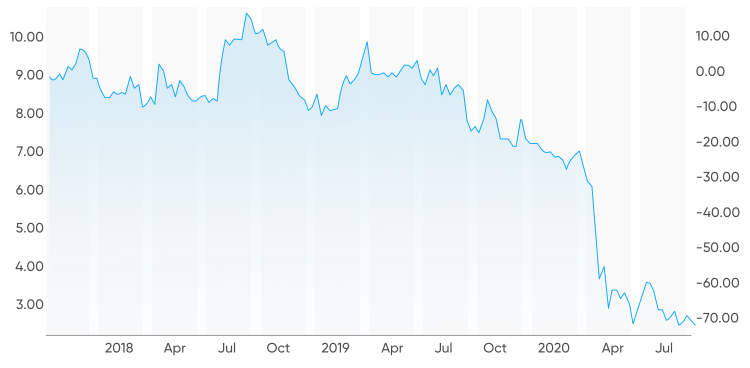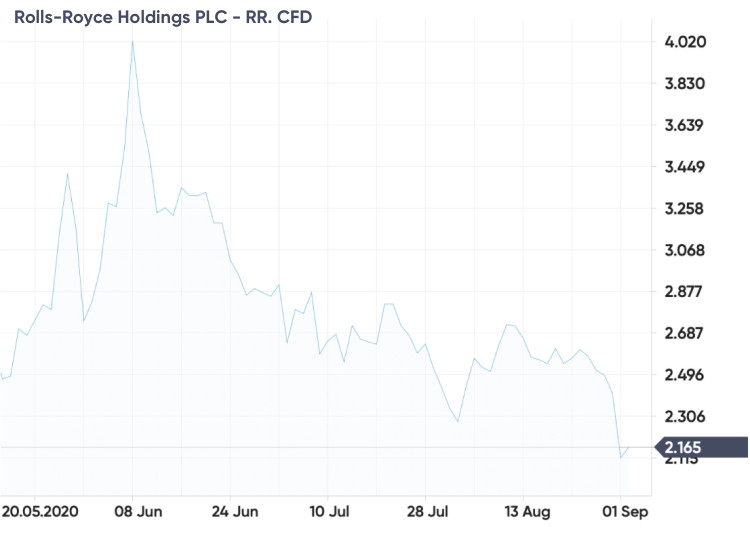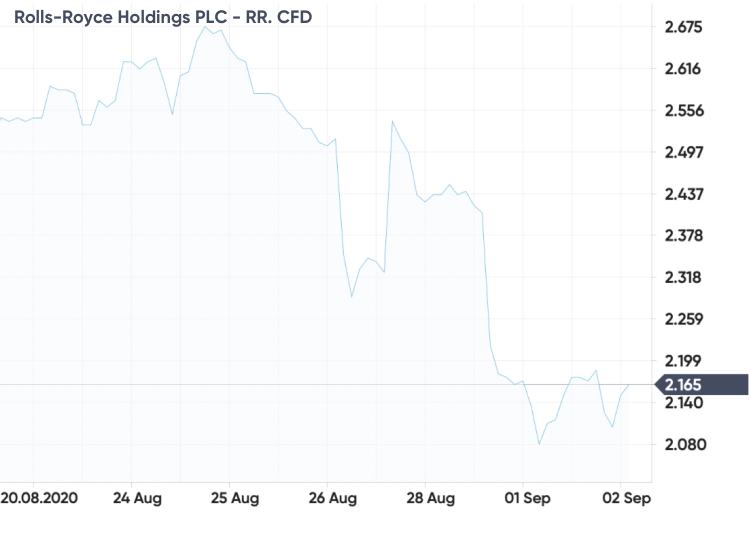Rolls-Royce share price history: from bad to worse to... better?
12:57, 9 September 2020

No, Rolls Royce doesn't make cars
What comes to mind when you hear “Rolls-Royce”? Probably a luxury car. But that's not the company we are talking about here. Rolls-Royce Motor Cars is a 100 per cent owned subsidiary of BMW, so you can't buy its stock.
By contrast, the enterprise we are looking at in this article is named simply Rolls-Royce (exchange ticker RR), and it's an engineering company. It makes engines for Boeing and Airbus, as well as for military jets, submarines and trains. However, it's the aircraft engines that account for half of the company's revenue.
What is your sentiment on EA?
2016-2019: plagued by the Trent 1000 curse
Rolls-Royce's problems began in 2016, when cracks were discovered in its Trent 1000 engine – one of the two engines used in the Boeing 787 Dreamliner (the other is by GE). Dozens of planes were grounded and RR's total bill to correct the problem ran up to $3 billion.
As a result, between January 1, 2018 and January 1, 2020 the RR share price tumbled 28 per cent from 859p to 619.3p. There were sharp drops in August 2019, when a Trent 1000 engine installed on a Norwegian Air plane fell apart over Italy; and then in September when the company said it would take six months longer than expected to fix the issue. All these slumps are clearly visible on this Rolls Royce share price history graph:
 Still, in terms of engine sales and profit 2019 was a good year for Rolls-Royce and the management was looking towards 2020 with much optimism.
Still, in terms of engine sales and profit 2019 was a good year for Rolls-Royce and the management was looking towards 2020 with much optimism.
![Rolls-Royce share price history Rolls Royce]() 2020: the Covid-19 disaster
2020: the Covid-19 disaster
The pandemic has kept most of the world's airlines grounded for months, so Airbus and Boeing won't order new engines from Rolls-Royce for a while. However, that's not the main problem.
Rolls-Royce doesn't actually make any money off sales: the price of an aircraft engine is below the cost of production. The main source of profits for the company are the fees that airlines pay for the hours flown, plus after-sales maintenance. But if a plane stays on the ground, there are no flying-hours fees and not much maintenance to do.
The whole Rolls Roys shares history in 2020 looks like one litany of misfortunes and bad news. Let's go through the most prominent events and how they affected the price.
April-May 2020: scrapped dividends and massive job cuts
On April 5, Rolls Royce announced that it would scrap the final dividend for the first time since 1987. By that date, the stock price was already down 57.5 per cent since the start of the year.

On May 20, the company said it would lay off 9,000 employees – almost 20 per cent of the total global workforce of which 8,000 are in the civil aerospace arm. The job cuts should allow the company to save more than £1.3bn. As a result, by May 29 the price reached 278.7p, or 60 per cent lower than at the start of the year.
July 2020: junk rating and rights issue
By mid-June, RR recovered about 10 per cent of the losses, but more trouble was on the horizon. On July 27, Moody's downgraded RR two steps from Ba2, which means non-investment grade – or simply junk.
Next, on July 29, reports surfaced that Rolls-Royce plans to raise an additional $1.9bn by issuing new shares in September. This move would bring in some much-needed cash, but it would also dilute existing shareholders' stock. The market responded to the news with a drop to 220p – the lowest point in 2020 and 68 per cent below January 1.
August: 2020 new engineering issues
Things haven't been good for Rolls-Royce on the customer relations front, either. On August 11, 2020, the company announced it had discovered cracks in some of its XWB-84 engines installed on Airbus 350. The cracks are classified as “abnormal wear”, meaning that they shouldn't be there. Now Rolls-Royce will have to check all of the XWB-84 in operation.

Though this issue isn't nearly as serious as what happened with Trent 1000 in 2018, it won't help RR's reputation. Trustworthiness is everything in aerospace, and Rolls Royce is struggling to look reliable.
August 27, 2020: a staggering $7.2bn loss
The scale of RR's problems became evident on August 27, when the company posted a record £5.4bn ($7.21bn) loss for the first half of 2020. Predictably, the share price fell even further: from 253.8p to 229.8, or by 4.7 per cent. Nevertheless, in the next three days it recovered back to 241.1p.
The company also confirmed that it would close its factories in Lancashire and Nottinghamshire, laying off 3,000 employees. It was also announced that the CFO has resigned.
In the commentary to the financial report, Rolls-Royce tried to stress the positive developments: that it managed to save £1bn through pay cuts and wage deferrals, that it plans to raise £2bn by selling its subsidiary ITP Aero, and that the worst period seems to be over in terms of fly hours. The company went as far as to say that 12 months from now the cash flow should turn positive again.
From Rolls Royce share price history to future predictions: should you buy?
At 241p, RR can seem like a very attractive deal right now. However, you should think twice before buying the stock. There are two reasons why the price of RR could fall even lower in the next couple of months.
1) Air travel disruptions continue. According to Rolls-Royce CEO Warren East, it will take five years for global air travel to recover to pre-Covid-19 levels. Meanwhile, airlines keep reducing their fleets to cut costs, and that means even less revenue for Rolls-Royce.
What makes things even worse is the fact that Rolls-Royce engines are mostly installed on big liners serving transcontinental flights. This segment will take the longest to go back to pre-Covid levels. Thus, Rolls-Royce will keep suffering losses even once manufacturers of smaller engines such as GE and Pratt & Whitney have recovered.
2) The rights issue. If Rolls-Royce does issue new stocks in September, it will be a sign that the situation is really dire and that RR didn't manage to raise enough cash through selling assets or borrowing from other sources.
However, if the price tumbles after the new shares are issued, RR may indeed become a good buying opportunity. Things should get better next year, and indeed the median price target offered by analysts is 353.88p, which is almost 47 per cent higher than the current price.
Moreover, remember that Rolls-Royce's defence business has remained strong in spite of the pandemic. It should at least keep the company afloat.
The Covid-19 pandemic is far from over, and the situation in air travel can change very quickly.

 2020: the Covid-19 disaster
2020: the Covid-19 disaster